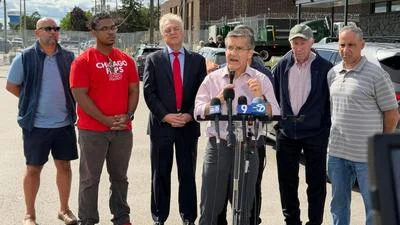Illinois Seasonally Adjusted Nonfarm Jobs by Major Industry
Illinois Seasonally Adjusted Nonfarm Jobs by Major Industry
Total unemployment in Illinois increased slightly in July, keeping the state's employment rate below the national average, according to the Illinois Department of Employment Security (IDES).
According to preliminary data provided by the U.S. Bureau of Labor Statistics and released by IDES, the Illinois jobless rate in July increased one-tenth of a percentage point from June to 4.8 percent, while nonfarm payrolls increased by 2,100 jobs.
Illinois’ unemployment rate in July was one-half percentage point higher than the national unemployment rate, which decreased to 4.3 percent.
“The strong employment growth exhibited in the U.S. is not being felt in Illinois,” IDES Director Jeff Mays said in a recent press release. “Nonfarm payroll growth in the state remains anemic and labor force participation continues to decline.”
The good news is that the Illinois unemployment rate is down 1.0 percentage point from one year ago, when it hit 5.8 percent, and is 0.9 percentage point lower than January 2017.
The first seven months of 2017 showed the state's payroll gains growing at twice the rate than the same period last year but only at half the pace of the first seven months of 2015.
July’s slight payroll gain was offset by 308,200 reported unemployed workers, a 2 percent increase from June.
The three industry sectors in the state that reported the greatest job gains in July were professional and business services, which led the way with 6,200 new jobs. The leisure and hospitality industry added 4,000 jobs, while jobs in "other services" increased by 1,800.
The largest payroll employment declines were in the trade, transportation and utilities sector, which saw a loss of 3,700 jobs. Education and health services dropped 3,200 jobs, and the construction sector shed 1,800 jobs.
The data, however, reflect pockets of modest job growth in the state’s over-the-year numbers.
Illinois saw an overall net increase of 33,200 jobs over-the-year. The largest gains were in the professional and business services sector, which saw an overall increase of 20,700 jobs. The leisure and hospitality sector saw the second-largest growth, with 11,600 new jobs. Financial activities followed by adding 9,500 jobs.
Large payroll employment declines were also reported. Trade, transportation and utilities eliminated 10,700 jobs, by far the most of any other sector. It was followed by 4,300 job losses in construction and 2,300 in the government sector.
“The modest gains in Illinois continue to lag behind the rest of the nation,” Sean McCarthy, director of the Illinois Department of Commerce, said in a recent press release. “We need reforms to provide business owners relief and incentives to make our state not only competitive but attractive to bring good jobs back to Illinois.”
In related news, IDES reported that it has made revisions to Illinois labor data as required by the U.S. Bureau of Labor Statistics.
The monthly 2012-16 labor force data for Illinois have been revised to reflect new national benchmark controls, state working-age population controls, seasonal factors, and updated total nonfarm jobs and unemployment benefits claims inputs.
In addition, the monthly 1990-2016 unadjusted and seasonally adjusted nonfarm payroll data for Illinois have also been revised to control survey error.






 Alerts Sign-up
Alerts Sign-up